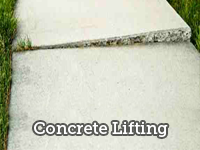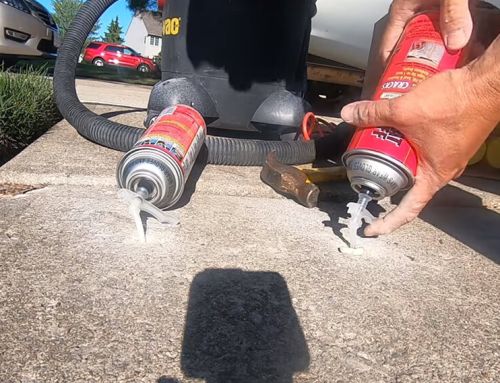IN THIS ARTICLE

The number one cause of concrete sinking or settling is normally poor base preparation, or the pouring of concrete on fresh, uncompacted soil. One other cause can be improper water drainage. This is a common problem both commercially and residentially on floors and slabs of all sizes, inside and out, including garage floors, swimming pool decks, walkways, etc.
Many people are not aware of it, but there is a solution. The process is called slabjacking. It is also referred to as mudjacking, concrete leveling, concrete lifting or concrete raising. The way the process works is a series of 1″ to 1 1/2″ holes are drilled through the concrete surface. Then a grout mix consisting of a non organic earthen material mixed with portland cement is pumped beneath the slab. Once the slab is returned back to it’s original height, the access drill holes are cleaned and patched with a quick set cement. The result is perfectly useable concrete once again, eliminating the need for replacement and the costs that go along with it. The cost is usually 1/3 to 1/2 the cost of concrete replacement, there is no disturbance to landscaping or surrounding areas and the concrete is useable the same day, eliminating down time.
Before assuming that your concrete can definitely be raised, there are some things that can prevent concrete from being practical to raise, or prevent it from lifting all together. First check to see if your concrete fits the description below.
1) Concrete is in basically good condition free from deterioration
2) Concrete has no major cracking, or is not cracked into several pieces. Note: some hairline cracks are acceptable
3) There are no major restrictions that can prevent the concrete from raising. An example would be a deck built on top of or fastened to the concrete that may prevent movement.
4) The concrete has actually settled and is not severely raised due to tree roots. Note: It is sometime possible to remove smaller trip areas caused by roots.
If you have ruled out some of the major obstacles above and feel your concrete can be raised, contact a slabjacking professional in your area. Be sure to check the contractors background through past references or supply yards. Also make sure you are dealing with a reputable, insured and licensed contractor.
- Garage Floor Raising and Coating: The Ultimate Guide - June 4, 2024
- Mudjacking Cost: 5 Factors That Affect It - April 10, 2024
- What is The Average Cost of Concrete Leveling in Belle Mead, NJ? - April 4, 2024



